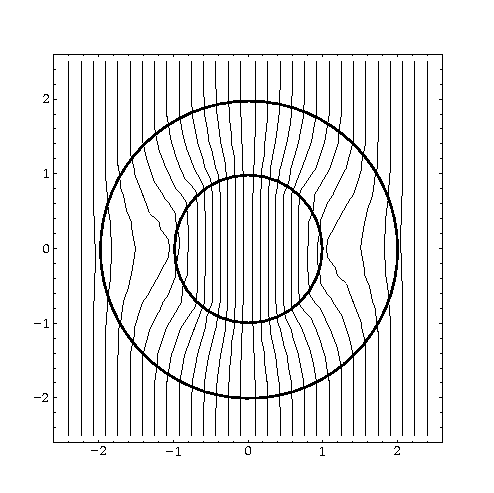Effective medium theory calculates effective properties for media with located symmetric inclusions. The approach leads to exact formulas for the effective conductivity. It was originated and discussed in [#!Bruggemann:1935:BVP!#,#!Bruggemann:1937:BVP!#,#!Hashin:1962:VATa!#,#!Christensen:19_79:MCM!#] and others. Specifically we discuss the structure of the ``coated spheres'' suggested in [#!Hashin:1962:VATa!#].
It should be mentioned that the structures obtained by using this method can also be obtained by using the described differential scheme. However, we feel that the description of the effective medium theory is helpful from both historic and aesthetic viewpoints.
Consider a homogeneous material with isotropic conductivity ![]() .
Suppose we replace the medium in a disk of unit radius with the following
two-phase configuration. The inner disk of radius
.
Suppose we replace the medium in a disk of unit radius with the following
two-phase configuration. The inner disk of radius ![]() is
filled with material
is
filled with material ![]() , and the annulus
, and the annulus
![]() is filled with material
is filled with material ![]() . This
configuration (see
. This
configuration (see ![]() ) is called the coated
circles (or, in three dimensions, the coated
spheres).
) is called the coated
circles (or, in three dimensions, the coated
spheres).

The geometry of coated circles\index{coated circles}. The field outside the external disk is homogeneous. The inner disk has higher conductivity than the effective medium, and the exterior annulus has lower conductivity than the effective medium. Observe the complete mutual compensation of the inclusion. The inclusion is ``invisible'' for an observer in a uniform external field.
Assume that the configuration is submerged into a uniform external field
![]() , when
, when
![]() .
The
corresponding potential
.
The
corresponding potential ![]() tends to the affine function
tends to the affine function
![]() .
.
Suppose we manage to define the conductivity ![]() so that the field
everywhere outside of the inclusion is a constant vector:
so that the field
everywhere outside of the inclusion is a constant vector:
![]() . In polar coordinates, this condition takes the form
. In polar coordinates, this condition takes the form
In this case, we cannot detect the presence of the inclusion by
observing the fields anywhere outside of the inclusion. Hence,
we cannot distinguish the homogeneous configuration with
conductivity ![]() from a configuration with one, or several, or
even infinitely many circular inclusions of the described type; see
from a configuration with one, or several, or
even infinitely many circular inclusions of the described type; see
![]() . In this
case we call
. In this
case we call ![]() the effective conductivity of a composite made
of coated circles.
the effective conductivity of a composite made
of coated circles.
To find ![]() , we explicitly calculate the field everywhere in
the configuration. The field satisfies the boundary value problem:
, we explicitly calculate the field everywhere in
the configuration. The field satisfies the boundary value problem:
This boundary value problem allows for
separation of variables; the solution ![]() has the form
has the form
![]() . The function
. The function ![]() must
satisfy the ordinary differential equation for
must
satisfy the ordinary differential equation for ![]()

The solution to 16 that satisfies the conditions 17 has
the form
The key point of the scheme is the following: We assign the constant
![]() in such a way
that
in such a way
that ![]() or that the field is homogeneous if
or that the field is homogeneous if ![]() . This way,
14 is satisfied.
. This way,
14 is satisfied.
Accounting for the constants, we have
Several generalization of the procedure were suggested.
A generalization of the procedure was suggested in [#!Milton:1980:BCD!#], which considered the geometry of ``coated ellipses'' (one inscribed into another) and found the explicit description of their effective properties. This time, the effective medium is anisotropic. The idea of the calculation is the same: We consider one ``coated elliptical inclusion,'' i.e., two ellipses in an unbounded domain and a homogeneous field applied at infinity. This time we use elliptical coordinates to separate the variables.
Another generalization is based on the construction by Shulgasser [#!Schulgasser:!#] who considered an invisible spherical inclusion from an anisotropic material with radial symmetry. In the workshop, we use a more sophisticated geometry placing an anisotropic material with radial symmetry into the outer layer of the coater spheres structure.
If the outer material is a laminate from radially oriented infinitesilmal thin layers and the nucleous is made out of one of the laminate's consistencies, then such geometry (the hedgehogs) models diffusive medium with inclusion.
If the layers in outer laminate are inclined to the radium, we obtain a spiral structure.
This construction is used in the Workshop.